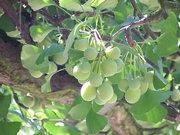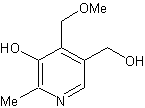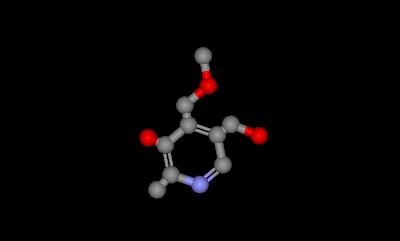
Table of Contents
History and Background Information
Main Poison agent: 4-O-methylpyridoxine
Other known Poisons in the Ginkgo plant
Extraction and Biosynthesis of 4-O-methylpyridoxine
Searching for Chemical Information
Interesting Information about Ginkgo
Bibliography
The Ginkgo Journey
1) Introduction: History and Background Information
The common name for this plant is ginkgo or maindenhair tree, its scientific name is Ginkgo biloba and its family name is Ginkgoaceae [1]. Originally thought to be extinct, Ginkgo grows in the areas of the Zhejiang province located in China [2]. Ginkgo is considered a living fosil since it's one of the oldest tree species living on earth [2]. Its origins go back 200 million years and it was also found in North America and Europe [3]. In terms of cultivation environment this plant offers some unique qualities. For example they manage to survive for many years due to their disease, pest and fire resistance capabilities [3]. Air pollution and its ability to grow in places where many plants would die make the ginkgo a versatile tree for growth [3]. The Ginkgo it’s one of the “world’s most urban-tolerant trees, often growing where other trees cannot survive” [3]. The fact that this tree can survive adverse conditions gives a reason why this three has been around for so long.
The Looks of Ginkgo
Picture from Wikipedia: Permission pending
Picture from Wikipedia: permission pending
2) Main Poison agent: 4-O-Methylpyridoxine
Structure of 4-O-Methylpyridoxine
Picture drawn in "Chemsketch"
3D Model from "Chem 3D viewer lite"
This poisonous agent is located in the seeds of the Ginkgo plant and it's a chemical with anti-vitamin B6 activity [4]. This means that it interferes with amino acid metabolism, and it has caused convulsions and even death in laboratory guinea pigs [5]. As frequent as food poisoning comes from spoiled food, Ginkgo seed poisoning also occurs in Japan and China [6]. This poison agent of the Ginkgo plant is located in its seeds and it’s a chemical with anti-vitamin B6 acvitivity [4]. This means that it interferes with amino acid metabolism, and has caused convulsions and even death in laboratory guinea pigs [5]. As frequent as food poisoning comes from spoiled food, Ginkgo seed poisoning also occurs in Japan and China. [6] There was no information on the therapeutic uses of this toxin but further research will be done.
An interesting fact about this known neurotoxin is the fact that when its phosphorylation indicates that when it has a phosphate (4’-O-methylpyridoxine-5-‘phosphate), it decreases that activity of Glutamate decarboxylase [7]. Since there is a reduction in the activity of this enzyme, the Glutamate may accumulate and have a detrimental effect on the brain. Results have shown that this toxin might be involved in the cause of epileptic seizures in some cases [8].
Toxic Effects of the Poison
3) Other known poisons in the Ginkgo plant
Another toxin is found in the leaves of this plant and it is "ginkgolic acid." This toxin has been reported to induce contact dermatitis [9].
4)Extraction and Biosynthesis of 4-O-methylpyridoxine
Ginkgo seeds are the main source of this compound and the overconsumption of seeds have caused toxicity and death in the past [11]. To extract this molecule, sample is placed in boiling water to later be saparated on a strong cation exchanger. The extract is then inserted into an HPLC (High Performance Liquid Chromatography) column to detect it by fluorescence detection [11]. Even though the 4-O-methylpyridixine (ginkgotoxin) could potentially be used for the study of the biosynthesis of vitamin B6 and its derivatives in higher plants, no reports about the biosynthesis of this compound have been published [12]. One of the ways that has been used to analyze (4-O-methylpyridoxine) is by using High- Performance Liquid Chromatography (HPLC). The method used is through a reverse-phase HPLC using fluorescence detection and UV detection [13]. The problem initially was that the procedures needed solid-phase extraction which proved to be difficult and a faster method was needed [13]. The HPLC column that proved more efficient was one that had an ion-pair reagent in the mobile phase which made things faster to use clinically [13].
5) Searching for Chemical Information
The link below contains information of how Scifinder was used to find results.
poison.rtf
The link below is the result for the "Substance Identifier task" on Scifinder.
6) Interesting Information about Ginkgo
- Ginkgo's leaf extracts are used as dietary supplements due to its beneficial effects on problems ranging from stroke to Alzheimer's disease [9].
- Mechanism of action is not well known [9].
- Its antioxidant properties have been shown to reverse the age of neurotransmitter systems [9].
- Potentially effective against disorders associated with decreased cerebral blood flow such as short term memory loss, dizziness, tinnitus, depression and headache[10].
- Anti-inflammatory effects produce positive effects on patients with allergies, asthma, bronchitis and others[10].
Bibliography
[1] Herbmed (Alternative Medicine Foundation Inc.) 1998-2006. Soaring Bear, pH.D. 1998, Updated by Michael C. Tims, pHD. Candidate 2003. Retrieved February 20, 2006. ( http://www.herbmed.org/Herbs/Herb1.htm )
[2] http://en.wikipedia.org/wiki/Ginkgo Retrieved: February 20, 2006.
[3] Steven Foster Group, 2000. http://www.stevenfoster.com/education/monograph/ginkgo.htmlRetrieved: February 20, 2006.
[4]Canadian Biodiversity Information Facility (CBIF)http://www.cbif.gc.ca/pls/pp/ppack.info?p_psn=136&p_type=all&p_sci=sci&p_x=px Retrieved: February 20, 2006.
[5] HerbalGram "The Journal of the American Botanical Council"Issue 69 HerbalGram. 2006;69 http://www.herbalgram.org/bodywise/herbclip/review.asp?i=42062 Retrieved: February 20, 2006.
[6] The International Association of Forensic Toxicologists, 1998.http://www.tiaft.org/tiaft98/thu/p/t_p_23.html Retrieved: February 20, 2006.
[7] Buss, K; Drewke, C; Lohmann, S; Piwonska, A; Leistner,Properties and interaction of heterologously expressed glutamate decarboxylase isoenzymes GAD(65kDa) and GAD(67kDa) from human brain with ginkgotoxin and its 5'-phosphate. E-Journal of medicinal chemistry, 2001 Sep 13, 44(19):3166-74. Retrieved: February 20, 2006.
[8] British Geriatrics Society ,2001. http://ageing.oxfordjournals.org/cgi/reprint/30/6/523.pdf#search='ginkgo%20neurotoxin' Retrieved: February 20, 2006.
[9] Health vs Disease http://www.healthvsdisease.com/health-vs-disease/diet-and-nutrition/ginkgo-biloba/ginkgo-biloba.htm Retrieved: February 20, 2006.
[10] Introduction to Herbal Supplements: Ginkgo Supplements http://www.mcphs.edu/rc/ccap/herbs/ginkgo_properties.htm Retrieved: February 20, 2006.
[11] Beek, T. Journal of Chromatography A , Volume 967, Issue 1 , 16 August 2002, Pages 21-55. Retrieved from: http://mutex.gmu.edu:2096/science?_ob=ArticleURL&_udi=B6TG8-45B6633-2&_user=650615&_coverDate=08%2F16%2F2002&_alid=374839585&_rdoc=10&_fmt=full&_orig=search&_cdi=5248&_sort=d&_st=0&_docanchor=&_acct=C000035118&_version=1&_urlVersion=0&_userid=650615&md5=f825251478af64f52c736fcac0944300 on March 3, 2006 from Elsevier Database.
[12] Journal of Natural Products, Volume 63, Issue 2 , December 31, 1999, Pages 185-189. Retrieved from: http://pubs.acs.org/cgi-bin/article.cgi/jnprdf/2000/63/i02/html/np990414+.html/QueryZIP/C3-I/((
on March 3, 2006 from ACS Database. (4-o-methylpyridoxine)) ( (biosynthesis))) (RDATE@@>=@@19901001) (RDATE@@<=@@20060131)


